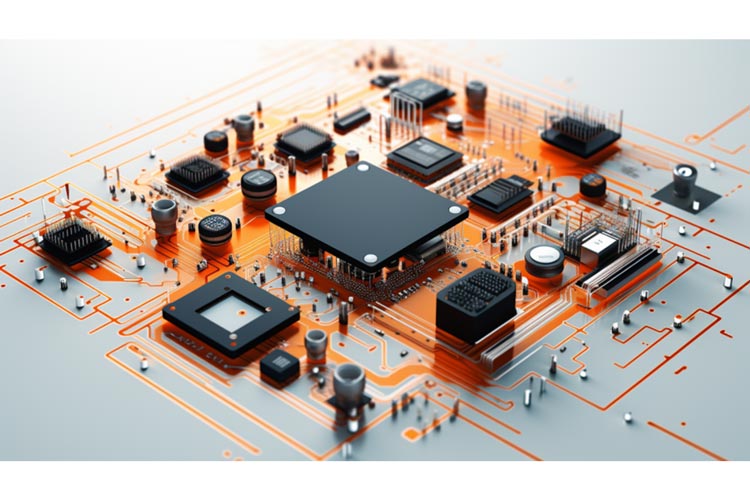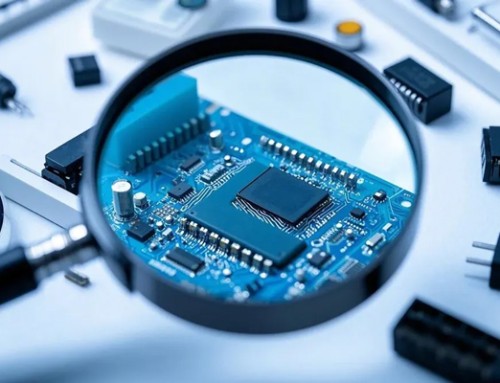The manufacturing process for printed circuit boards (PCBs) usually includes a procedure known as reflow soldering, or reflow. Reflow involves covering the surface of the PCB with solder paste to facilitate temporary attachment of the board’s thousands of minuscule components to their PCB pads. The solder paste stabilizes the components long enough for an application of high heat. The high heat reflows the solder – that is, it turns the paste into a molten substance that flows across the board – creating permanent solder joints that cement the components firmly in place.
Reflow soldering is a useful technique, but as in many manufacturing processes, especially those involving masses of tiny parts, there’s always the potential for an error to crop up. Among reflow soldering defects in PCBs, non-wetting is not uncommon, and it can have serious implications for the structural integrity and performance of the defective boards. Fortunately, it’s possible to take precautions to improve board wetting and prevent this defect.
In this article, we discuss the soldering defect known as non-wetting, and explain its frequent causes and potential remedies, you’ll have a clear representation of what can go wrong and how to make it right.
What is a non-wetting defect?
A non-wetting defect is a soldering defect that occurs when molten solder fails to bond with the base metal on the board. When this bond fails to materialize, the solder may not adhere to the components’ terminals or the PCB pads to allow them to stick securely to one other. The board’s surface material will remain exposed, and the solder itself may look grainy or lusterless. Non-wetting also leads directly to voiding – the creation of holes within a solder joint that lack solder material.
Non-wetting vs. Dewetting
A non-wetting defect is different from dewetting. What is the meaning of solder dewetting?
Dewetting occurs when the molten solder does initially coat the component terminals and PCB pads but then recedes from these parts, leaving some thin areas of solder on the base metal and some irregular, thick clumps. The surface material of the board usually does not remain exposed. When dewetting occurs, it usually affects solder joint s and the quality of their fillet.
Non-wetting defects often, though not always, occur with lead-free solders like tin-silver-copper solders. Some metals are more prone to non-wetting than others because different metallizations have different wicking and spread characteristics. Bare copper boards coated with organic solderability preservative (OSP) are often susceptible to non-wetting of the PCB pads, especially if they have undergone more than one thermal cycle. On the other hand, pure tin tends to spread well and reduce non-wetting, as do silver immersion finishes. Nickel-and-gold alloys also tend to solder well and minimize non-wetting as long as they don’t contain impurities.
Why it’s important to fix non-wetting defects
Why is it so essential to address non-wetting defects on PCBs? Non-wetting can cause severe structural issues that impair a board’s function and performance.
Non-wetting on a PCB creates unstable solder joints. When joints on a circuit board are unstable, they may break or provide poor electrical conductivity. And when solder does not adhere to the base metal, components and PCB pads will not be fixed firmly to the board. They may be loose and form poor connections, or they may fall off, either immediately or when subject to stress. Without its proper components fixed firmly in place, the PCB will not function correctly.
Common cause of non-wetting defects
Non-wetting defects have several common causes. Below are many reasons non-wetting can occur on a PCB:
1. Inadequate PCB Finish
The finish on a printed circuit board goes a long way toward determining how well the solder will reflow and how much wetting will occur. If the finish is inadequate and much of the bare board remains exposed, the solder will reflow with more difficulty and stick poorly to the PCB.
2. Improper Pin Plating
If the copper pins on a PCB receive inadequate copper plating before undergoing tin/lead plating, thy may become susceptible to non-wetting. The reason is that sufficient copper plating is essential for preventing zinc from interfering with the tin/lead plating and keeping the solder from adhering correctly.
3. Degraded Flux
Old and degraded flux – the chemical cleaning agent used before and after soldering – can quickly lead to non-wetting. Flux degrades quickly in an open container. Even if its solids content remains constant, its performance will diminish substantially. Regular flux changes help prevent this issue.
4. Wrong Type of Flux
The type of flux used for cleaning may also determine whether non-wetting occurs on a PCB. In general, high-activity fluxes lead to good solderability and a smaller risk of non-wetting. Conversely, low-activity, low-residue fluxes may cause poor solderability and an increased likelihood of non-wetting. A flux with low activity will be insufficient to remove oxides from the surface of the PCB, and the oxides will impede wetting.
5. Incorrect Tin/Lead Times
When boards contain too thin a plating of tin and lead, the incorrect thickness leads to poor solderability and non-wetting. A thinner coating has a shorter shelf life and may not last until soldering occurs.
6. Long Storage Times
If the board remains in storage too long, effective soldering becomes more difficult, and the likelihood of non-wetting rises. As we’ve seen, solderability generally corresponds directly to plating thickness. During a long storage period, the plating necessary for good solderability may break down. A PCB stored for a year or more may be at increased risk of poor solderability and non-wetting.
7. Poorly Applied Board Resin
If the resin on a PCB smears, it may interfere with soldering and cause non-wetting. For example, board resin may smear onto the corners of a pin and cause non-wetting in those areas.
8. Problems With the Bath
In some cases, non-wetting may occur across the printed board coating. For example, a gold surface coating on a PCB might cause non-wetting all across its surface because of imbalances in the electroless gold bath.
9. Oxidation
Oxidation on the surface receiving soldering can often lead to non-wetting. The oxides intervene between the solder and the base metal and prevent proper adhesion. When this happens, non-wetting can occur over every part of the surface that has become oxidized.
10. Insufficient Solder Paste
A low volume of solder paste frequently causes non-wetting because an adequate spread of solder paste is necessary for ensuring stable solder joints. When PCB assembly uses too little solder paste, proper adhesion between the solder and the base metal surface of the board cannot occur. Fortunately, a sufficient application of solder paste often results in 100% wetting of a PCB.
11. Poor Choice of Solder Paste
Some solder pastes perform better to prevent non-wetting than others. Generally, as with fluxes, a high-activity solder paste will be more effective than a low-activity solder-paste. It will enhance solderability and minimize the risk of non-wetting.
12. Expired Solder Paste
If the solder paste used on the board has passed its expiration date, it will not contain strong enough flux. The flux will not be active enough to remove oxides from the board and allow for good solderability and wetting.
13. Insufficient Soldering Temperatures
Soldering temperatures that are too low tend to promote non-wetting on a circuit board. Solder requires a certain thermal threshold to bond properly with the base metal. If the temperature during soldering does not reach that threshold, the solder will not adhere correctly to the components or the PCB pads. This difficulty is particularly common with lead-free alloys, which tend to have higher melting points than tin/lead alloys.
14. Inconsistent Soldering Temperatures
Inconsistent or fluctuating soldering temperatures can lead to non-wetting on a PCB because they fail to activate the flux and promote poor adhesion of the solder in certain areas. If specific trouble spots on the PCB don’t receive heat that reaches the flux’s activation temperature, the solder will not stick to those regions as it should.
15. Too Short a Soak Time
The length of time the solder remains on the board directly affects its ability to bond with the base metal of the PCB surface. If the solder does not have enough time to adhere properly, non-wetting is likely to occur in particular locations or across the board.
16. Too Long a Soak Time
Alternatively, if the solder remains on the board too long during the reflow process, the extensive time may exhaust the flux before soldering can take place. If the flux becomes inactive because of the long soak time, the likelihood of non-wetting rises substantially.
17. Solder Paste and Plating Material Mismatch
If the type of solder paste and the plating layer material on the board are incompatible, the solder paste will be ineffective in enabling connections between the surface components and the pads on the board.
18. Smaller Chips
Smaller chips necessarily contain a thinner layer of solder paste. In these cases, the layer of solder paste may be insufficient to allow for proper wetting of the entire PCB.
19. Contaminated Flux or Solder Paste
Contaminated flux or solder paste will not cleanse the board or connect components effectively and allow for adequate wetting. Contaminants may also leave unwanted residues on the PCB that interfere with solder flow and cause non-wetting.
How to correct non-wetting defects
To correct these defects, you can take a few different steps to promote good wetting or address non-wetting if it occurs despite your best efforts.
1. Reduce Oxidation
Oxidation is one of the most common causes of non-wetting defects in PCBs. Reducing oxidation in the solder powder, component leads and PCB pads before reflow can significantly lower the potential for poor wetting of the board.
2. Adjust the Reflow Profile
To prevent non-wetting defects, you may want to start by tweaking your reflow profile to minimize temperature differentials. You can adjust and optimize the reflow profile by changing the soaking zone to provide the proper temperature ramp-up and exposure and prevent defects.
3. Reduce Overall Heat Input
Because having too steep a temperature ramp-up during reflow can cause defects like bridging, solder balling, tombstoning and microcracking, manufacturers often raise the overall heat profile to make the temperature ramp-up more moderate. However, too much heat too early can cause non-wetting, as well as other serious problems like board delamination and component burning. Too-high heat input can also reduce the flux activity of the solder paste if the paste has limited oxidation tolerance, again leading to poor wetting.
4. Raise Peak Reflow Temperature
Though overall heat input shouldn’t be too high, the peak reflow temperature needs to hit a certain threshold. If the reflow temperature never becomes hot enough, proper wetting cannot occur, so facilities must monitor their peak reflow temperature carefully.
5. Reduce Profiling Time
Reducing soaking time during reflow is often beneficial for reducing non-wetting across the PCB. Reducing the soak time helps make sure the flux stays active, removes oxides and facilitates proper wetting.
6. Maintain the Appropriate Storage Environment
Make sure the storage environment for your PCBs is ideal for maintaining their quality over time. If the temperature and humidity in the storage area don’t meet the standards for long-term PCB storage, consider making adjustments or choosing another storage location.
7. Pay Attention to Storage Times
Even if your storage area meets the requisite standards, it’s best not to use a PCB that has been in storage for over a year without a protective cover plate. A board stored for that long may have degraded plating, which will lead to poor solderability and a high likelihood of non-wetting defects.
8. Check Solder Paste Freshness
As we’ve seen, the quality of the solder paste used on a PCB has a direct effect on solderability and the potential for non-wetting. If your solder paste is aging or expired, look for fresher paste that will allow for sufficient wetting across the board.
9. Use High-Quality Metal Surface Finishes
Because some non-wetting defects occur due to inferior metal surface finishing on the PCB, attending to the quality of the finish is critical. Using a high-temperature resistant OSP is one possibility — another is using electroless nickel immersion gold (ENIG).




